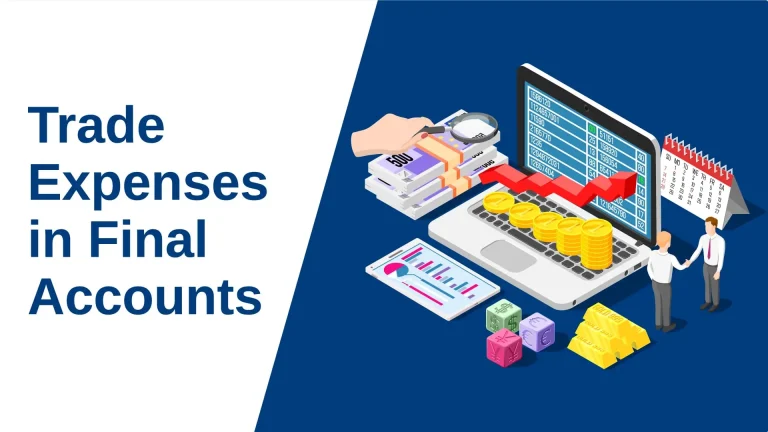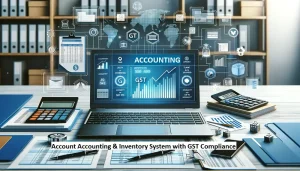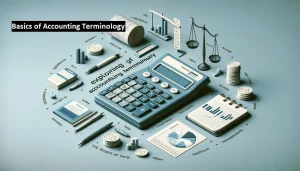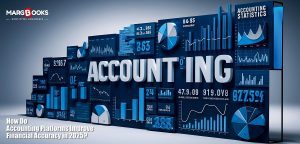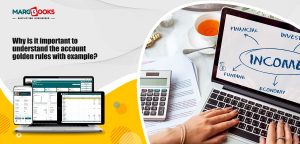In the world of accounting, keeping track of a company’s finances is vital for understanding its health and progress. Final accounts, which summarize a company’s financial situation, play a crucial role in this process. One important aspect of final accounts is trade expenses. In this article, we’ll explore what trade expenses are, why they matter, and how they affect a company’s financial statements.
Explaining Trade Expenses in Final Accounts:
Trade expenses cover all the regular costs a business faces while operating. These expenses are necessary for the business to function smoothly. They include things like buying materials, paying bills, marketing the company, and delivering products to customers. Essentially, trade expenses are the day-to-day costs of running a business.
Components of Trade Expenses:
Let’s break down trade expenses into their main parts:
- Procurement Expenses: This includes the money spent on buying materials or services needed for the company’s products or services. It covers everything from purchasing items to getting them to the company’s premises.
- Operating Expenses: These are the costs of keeping the business running smoothly. They include rent, utilities, employee salaries, and other overheads needed to keep the lights on and the business moving forward.
- Marketing and Advertising Expenses: To attract customers, businesses need to invest in marketing and advertising. This category includes spending on advertising campaigns, promotions, and market research to reach potential customers and grow the business.
- Distribution Costs: Once products are ready, they need to reach customers. Distribution costs cover everything involved in getting products from the company to the customer, such as warehousing, transportation, and packaging.
- Administrative Expenses: These are the costs of managing the business behind the scenes. They include salaries for administrative staff, office supplies, and other expenses related to running the administrative side of the business.
Implications on Financial Statements:
Including trade expenses in final accounts has important implications for a company’s financial statements:
- Income Statement: Trade expenses are subtracted from the company’s total revenue in the income statement to calculate its net income or loss. This shows how much profit the company made after accounting for all its expenses.
- Balance Sheet: Trade expenses affect the balance sheet by influencing the company’s assets and liabilities. For example, prepaid expenses are listed as assets because they represent future expenses that have already been paid for.
- Cash Flow Statement: Trade expenses are also reflected in the cash flow statement, which tracks how money moves in and out of the company. By showing the cash spent on trade expenses, the statement helps assess the company’s ability to meet its financial obligations.
Expanding Further on Trade Expenses:
Now that we have a grasp of what trade expenses entail and their significance in financial reporting, let’s delve deeper into their role within a company’s operations and the broader implications they carry.
- Operational Efficiency: Efficient management of trade expenses is crucial for maintaining the overall health and sustainability of a business. By carefully monitoring and controlling these expenses, companies can optimize their operational efficiency, minimize waste, and enhance profitability. Implementing cost-effective measures and streamlining procurement processes can lead to significant savings in the long run, bolstering the company’s bottom line.
- Budgeting and Planning: A thorough understanding of trade expenses is indispensable for effective budgeting and strategic planning. By accurately forecasting future expenses and allocating resources accordingly, businesses can mitigate financial risks, seize growth opportunities, and align their expenditures with overarching business objectives. Robust budgetary frameworks enable companies to prioritize spending, allocate funds to critical areas, and adapt swiftly to changing market dynamics.
- Cost-Volume-Profit Analysis: Trade expenses play a pivotal role in conducting cost-volume-profit (CVP) analysis, a fundamental tool for assessing the relationship between costs, sales volume, and profitability. By analyzing the impact of changes in trade expenses on the company’s breakeven point and profit margins, businesses can make informed decisions regarding pricing strategies, product mix optimization, and resource allocation. CVP analysis provides valuable insights into the cost structure of the business and helps identify areas for cost reduction or revenue enhancement.
- Taxation and Compliance: Proper documentation and classification of trade expenses are essential for ensuring compliance with tax regulations and financial reporting standards. Accurate recording of expenses allows businesses to claim eligible deductions, minimize tax liabilities, and maintain transparency in their financial disclosures. Failure to adhere to regulatory requirements can result in penalties, audits, and reputational damage, underscoring the importance of meticulous record-keeping and adherence to accounting principles.
- Investor Confidence and Stakeholder Relations: Transparent reporting of trade expenses fosters trust and confidence among investors, creditors, and other stakeholders. Clear articulation of the company’s financial performance, including its expense management practices, enhances transparency and accountability, thereby bolstering investor confidence and facilitating access to capital. Timely and accurate financial reporting instills credibility in the company’s operations, strengthening its reputation and fostering positive relationships with stakeholders.
Trade Expenses Example
Below is an example of how trade expenses might be listed in a financial report:
| Expense Category | Amount |
|---|---|
| Raw Materials | $5,000 |
| Direct Labor | $3,000 |
| Advertising | $1,500 |
| Utilities | $800 |
| Transportation | $600 |
| Administrative Salaries | $2,000 |
In this example, we have various trade expenses listed, including costs for raw materials, direct labor, advertising, utilities, transportation, and administrative salaries.
Indirect Expenses are Debited to Trading Account
In the world of accounting, when we talk about indirect expenses, these are the costs that aren’t directly linked to making or selling products. Think about things like office rent, salaries for non-production staff, or money spent on advertising. These costs are important to track because they affect how much money a company really makes from selling its products. So, in the trading account, we record these indirect expenses. By doing this, we get a clearer picture of how much profit the company is really making after considering all its costs.
Trading Account is Prepared on the Basis of Which Expenses?
When we’re getting ready to make a trading account, we gather up all the expenses the company had during the trading period. These expenses cover everything from buying materials to paying for ads or salaries. Some of these expenses are directly related to making the products, like buying raw materials, while others are more about running the business, like paying rent or salaries. The trading account helps us see how much money the company made from selling its products and how much it spent to make those sales happen.
Trade Expenses is Direct or Indirect
Trade expenses can be a mix of direct and indirect costs, depending on what they’re for. Direct trade expenses are the ones directly tied to making or buying products for sale, like the cost of raw materials or the wages of workers making those products. On the other hand, indirect trade expenses are more about running the business as a whole, like advertising costs or office rent. It’s important to figure out which expenses are which so we can track them properly and understand how they affect the company’s finances.
Trade Expenses in Trial Balance
In the trial balance, we put together all the different income and expenses to make sure everything adds up correctly. This includes trade expenses, which are the total amount of money spent on different things related to the company’s trading activities. We use this trial balance to help us make the trading account later on, where we’ll break down these expenses and see how they relate to the company’s sales revenue.
Trading Account is Prepared on The Basis of Expenses:
To prepare a trading account, we gather up all the expenses the company had during the trading period. These can be direct costs, like the money spent on making products, or indirect costs, like running the office or advertising. By adding up all these expenses and comparing them to the company’s sales revenue, we can figure out how much profit the company made from its trading activities.
Trade Expenses Journal Entry
When we record trade expenses in the accounting system, we make a journal entry. This entry helps us keep track of where the money went and how it affects the company’s financial position. For example, if the company spends money on advertising, we’d record that by debiting the advertising expense account and crediting the cash account if the expense is paid immediately. Properly recording these expenses ensures that our financial records are accurate and follow accounting rules.
Also Read:
- The ABCs of Account Accounting & Inventory System with GST ComplianceIn today’s fast-paced business world, keeping track of money and goods is crucial. That’s where an account accounting and inventory management system with GST compliance comes in. Let’s break down what it is, why it’s essential, and why using a… Read more: The ABCs of Account Accounting & Inventory System with GST Compliance
- Exploring Basics of Accounting TerminologyWelcome to the world of finance made simple! In this easy-to-follow guide, we’re breaking down the basics of accounting terminology. Whether you’re a business owner, a student, or just someone curious about money matters, we’re here to demystify the language… Read more: Exploring Basics of Accounting Terminology
- What is Online Accounting Software?Businesses are always looking for ways to make managing money easier. One tool that helps a lot is online accounting software. In this guide, we’ll talk all about it—what it is, what it does, and how it’s changing businesses, especially… Read more: What is Online Accounting Software?
- How to Prepare Final AccountsSetting out on the path towards final accounts offers an incredible glimpse into a company’s intricate financial story. Let’s examine key components that contribute to this tale while demystifying final account preparation complexities. Understanding Final Accounts: Final accounts are like… Read more: How to Prepare Final Accounts
Frequently Asked Questions
What are trade expenses in final accounts?
Trade expenses in final accounts refer to the costs incurred by a business during its trading activities. These expenses include everything from buying raw materials to paying for advertising or administrative salaries. They are crucial for determining the profitability of the company’s trading operations and are reflected in financial statements such as the trading account.
Are trade expenses considered indirect expenses?
Yes, trade expenses are often categorized as indirect expenses. Indirect expenses are those costs that are not directly tied to the production or sale of goods but are necessary for the overall operation of the business. Examples of indirect trade expenses include administrative salaries, advertising, utilities, and transportation costs.
How are indirect expenses treated in the trading account?
Indirect expenses, including trade expenses, are debited to the trading account. This means that they are subtracted from the company’s total revenue to calculate the gross profit. By debiting indirect expenses to the trading account, businesses can accurately assess their profitability by considering all relevant costs incurred during the trading period.
What basis are trading accounts prepared on?
Trading accounts are prepared on the basis of both direct and indirect expenses incurred during the trading period. Direct expenses are those directly related to the production or purchase of goods for resale, while indirect expenses are more about running the business as a whole. By including both types of expenses, the trading account provides a comprehensive overview of the company’s trading activities.
Are trade expenses considered direct or indirect?
Trade expenses can be both direct and indirect, depending on their nature and relation to the production or sale of goods. Direct trade expenses are those directly attributable to making or buying products for resale, such as raw material costs or direct labor. Indirect trade expenses, on the other hand, are more about running the business overall, like advertising or administrative salaries.
How are trade expenses recorded in the trial balance?
In the trial balance, trade expenses are recorded along with all other income and expenses to ensure the accuracy of the accounting records. These expenses represent the total amount spent on various operational activities related to the company’s trading operations and are used to prepare the trading account.
What is the journal entry for trade expenses?
The journal entry for trade expenses involves debiting the respective expense accounts and crediting the accounts payable or cash account, depending on whether the expenses are paid immediately or on credit. For example, if the company incurs advertising expenses and pays for them immediately, the journal entry would debit the advertising expense account and credit the cash account.
How trading accounts are prepared based on expenses?
To prepare a trading account, all expenses incurred during the trading period are gathered. These expenses include both direct costs, like the money spent on making products, and indirect costs, like running the office or advertising. By adding up these expenses and comparing them to the company’s sales revenue, the trading account shows how much profit the company made from its trading activities.
Why are indirect expenses debited to the trading account?
Indirect expenses, including trade expenses, are debited to the trading account to accurately calculate the company’s gross profit. By subtracting these expenses from the total revenue, businesses can assess their profitability by considering all relevant costs incurred during the trading period.
How do trade expenses impact final accounts?
Trade expenses impact final accounts by influencing the company’s financial performance and profitability. These expenses are reflected in financial statements such as the trading account, income statement, balance sheet, and cash flow statement. By accurately documenting and analyzing trade expenses, businesses can make informed decisions to optimize their operations and achieve long-term success.

